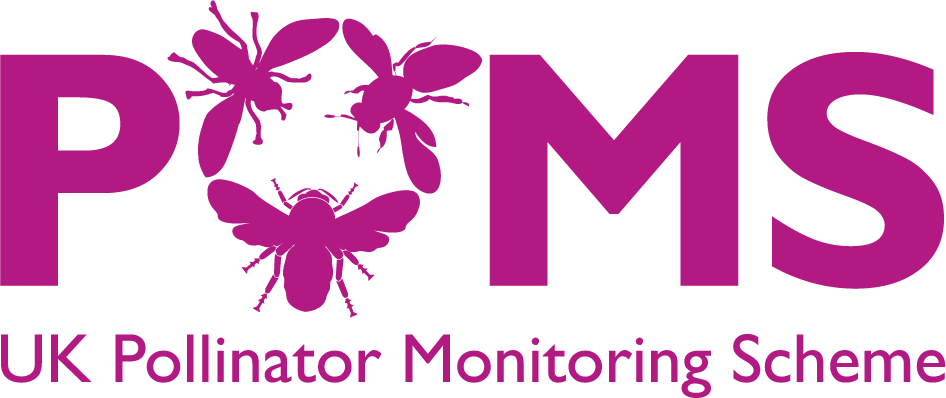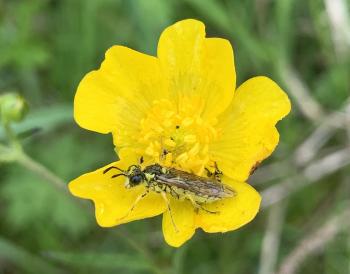Buttercups' glow attracts insects (and people)!
Holding a buttercup up to your chin has been said to show whether you like butter or not – lighting up your skin if you do. This evolutionary feat is a feature of Buttercup's petals, a trick of the light designed to catch the eye. FIT Counts show that this strategy works just as well for insects as it does for people, with 738 counts completed on Buttercups from 2017 to 2020 - the greatest number of FIT counts for a target flower!
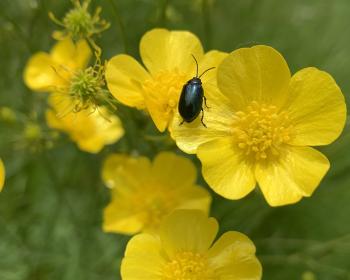
Buttercups are target flowers for FIT Counts - Robin Hutchinson |
Where to find a Buttercup
Buttercups are commonly found near water, earning the latin name Ranunculus (which means "little frog") for their tendency to appear in the same aquatic environments (Lehnebach, 2008). However, there are many species of Buttercup in the UK, and their habitat preferences differ quite greatly. They are most often associated with lawns, where they can tolerate mowing, but they can also be found in grassy meadows and pastures, wet woodlands, dunes, roadsides and even rocky outcrops (Plantlife, 2022). Wherever you are, look out for Buttercups between May and August! You can complete a FIT Count on any Buttercups you find, and don't need to identify them to species, but the BSBI (Botanical Society of Britain and Ireland) has produced a great guide to the four most common species if you would like to see which Buttercups are about near you.
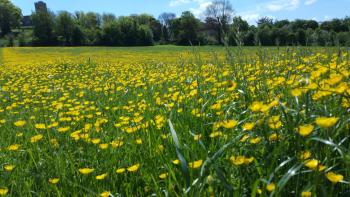
Buttercups can be found in a variety of habitats - Martin Harvey |
FIT Counts and Buttercups
Buttercups are not fussy when it comes to pollinators, with FIT Count recorders spotting insects from a variety of different groups. In fact, which insects are seen visiting Buttercups can be largely dependent on where the Buttercup is growing. Many insects that live in a particular habitat will happily visit any buttercups nearby (Steinbach and Gottsberger, 1995). By a whisker (or antenna), flies are the most common insects seen (30% of all insects seen on Buttercups), with small insects coming in second at 28% of the total insect count. Buttercups are popular with all sorts of insects, including pest-control experts such as hoverflies and wasps.
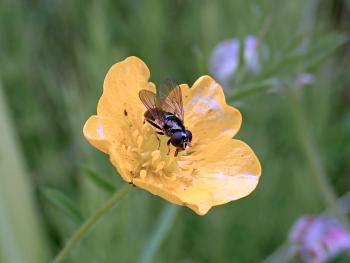
Flies are the most common insects seen - Martin Harvey |
There are still some specialist insects to look out for in a Buttercup FIT Count. Chelostoma florisomne (the Large Scissor-bee), for example, has a very strong preference for Buttercups, and will only visit species in the Buttercup genus – the males even use the petals as shelter in bad weather (Edwards, 2012)! Some beetle species are reported to love Buttercups too, with clusters of Raspberry Beetles often seen feeding on the flowers (UK Beetles, 2022). While other insects have not evolved to be Buttercup specialists, insects can learn to identify Buttercups based on colour and shape in areas where Buttercups are particularly common. This means that pollinating insects can easily fly from flower to flower, transferring pollen as they go (Steinbach and Gottsberger, 1995).
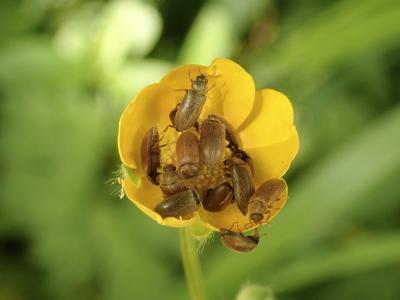
Byturus spp. (such as Raspberry Beetles) are often seen feeding on Buttercups - Martin Harvey |
How do Buttercups attract insects?
Accessibility is key to attracting a large variety of insects. A Buttercup's round, open structure means that any passing insect could stop and drink the nectar. The scent emitted by Buttercup flowers is also attractive to many pollinating insects. They use the same group of chemical volatiles as many other generalist plants, such as Blackberries and Raspberries (Dobson, 2006).
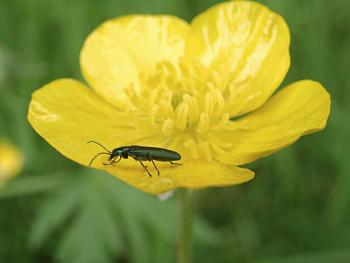
Buttercup petals reflect light - Martin Harvey |
However, what makes Buttercups special is how they use light to catch an insect’s eye. Shiny Buttercup petals absorb blue-green light while reflecting out yellow and UV light. As Buttercups are bowl-shaped, this reflected light becomes more focused, bouncing out of the flower and into the eye of a passing insect (Vignoli et al., 2011). Prompted to take a closer look, the gloss of the petals can look like nectar drops to an insect (Cam.ac.uk, 2011). This entices insects to land on a Buttercup and drink their nectar, playing a vital role in the Buttercup's pollination in the process.
|
Insects transfer pollen while visiting Buttercups - Robin Hutchinson |
Get counting!
On a sunny day, Buttercup’s reflective abilities can result in high FIT Counts, with the highest score last year being 40 insects in 10 minutes! Even on a cloudy day, insects will stop by to take advantage of this accessible nectar source. I counted 3 insects on a cloudy day last week, which was not far off May’s average of 6 insects per count. Why not take ten minutes to do a FIT count of your own, and see which insects land on your Buttercups?
By Robin Hutchinson
